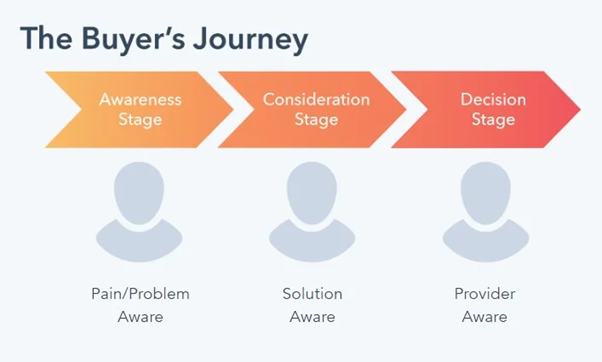It’s true what they say: if you fail to plan, you plan to fail.
In today's dynamic and competitive business landscape, having a well-crafted inbound marketing plan is crucial to stand out from the competition and drive meaningful results. Without one, your company won’t see the growth it deserves.
With the right strategies and best practices in place, you can attract more qualified leads, nurture customer relationships, and ultimately grow your business. This comprehensive blog post explores the key steps and tactics to create a comprehensive B2B inbound marketing strategy for your business – let's jump in.
Defining Your Target Audience
To develop a successful B2B inbound marketing strategy, it's crucial to have a deep understanding of your target audience. Defining your ideal customer profile and creating detailed buyer personas allows you to tailor your marketing efforts to meet their specific needs and pain points. By identifying the demographics, challenges, goals, and preferences of your target audience, you can effectively develop personalized content and campaigns that resonate with them.
To begin, conduct market research and analyse your existing customer base to identify common characteristics and patterns. You could even create a survey to circulate around your team and/or your prospective or active customers to dig deep into your ideal targets, identifying what habits they share or what their common pain points are. The more people who contribute, the better you’ll be able to understand your buyer persona.
This data will help you create buyer personas that represent your ideal customers. Consider factors such as job titles, industries, company sizes, pain points, and motivations. Developing accurate and detailed buyer personas ensures your marketing messages are highly targeted and relevant to your audience.
Researching the Buyer's Journey
Understanding the buyer's journey is vital for crafting an effective B2B inbound marketing strategy. The buyer's journey encompasses the stages a prospect goes through before making a purchase decision, including:
- Awareness: Your prospect is aware of a certain problem they want to solve.
- Consideration: Your audience is considering the options they have to solve their problem, conducting research into the available options.
- Decision: Your buyer is ready to decide on the right provider to give them a solution.
By mapping out these stages and aligning your marketing strategies accordingly, you can deliver the right content at the right time, guiding prospects smoothly through their decision-making process.

Start by analysing the touchpoints and interactions that occur during each stage of the buyer's journey. Identify the questions and concerns prospects may have at each stage and create content that addresses those specific needs. For example, in the awareness stage, focus on creating educational and informative content that raises awareness about the challenges your prospects face.
In the consideration stage, you could provide detailed comparisons and case studies to demonstrate the value of your solutions. Finally, in the decision stage, offer content that highlights the benefits and unique selling points of your products or services, showcasing why your buyer should pick you as their solution.
Developing Compelling Content
Content lies at the heart of successful inbound marketing. High-quality content addresses your audience's pain points, offers solutions, and showcases your expertise, attracting and engaging potential customers.
Struggling with writers' block? Here are some tips to start developing your content:
- Content Formats: Diversify your content formats to cater to different preferences and consumption habits. Consider using blog posts, whitepapers, case studies, videos, webinars, infographics, and interactive content within your strategy, at different points during the buyer’s journey.
- Storytelling Techniques: Tell captivating stories that resonate with your target audience. Use real-life examples, success stories, and customer testimonials to create emotional connections and build trust.
- Customer-Centric Approach: Focus on creating content that is customer-centric and provides value to your audience. Address their pain points, answer their questions, and offer actionable insights and solutions.
- SEO Optimisation: Incorporate relevant keywords naturally into your content to improve its visibility in search engine results. Conduct keyword research to identify the terms your target audience is searching for and produce content that ranks on search engines, making you easily discoverable for your audience – more on that soon!
- Consistency and Frequency: Consistently deliver valuable content to your audience. Develop a content calendar and establish a regular publishing schedule to maintain engagement and build brand loyalty.
Leveraging Search Engine Optimisation (SEO)
SEO plays a vital role in driving organic traffic to your business's website. By optimising your website and content for relevant keywords, you can improve your visibility in search engine results and increase the likelihood of attracting qualified leads. Here are key tips for leveraging SEO in your B2B inbound marketing strategy:
- Keyword Research: Conduct thorough keyword research to identify the terms and phrases your target audience is using in their searches. Utilise keyword research tools to discover relevant keywords with moderate search volume and low competition.
- On-Page SEO: Optimise the elements within your website to improve its search engine visibility. This includes optimizing meta tags (titles and descriptions), headings, URL structures, and image alt tags.
- Off-Page SEO: Build external credibility and authority for your website through off-page SEO techniques. Acquire high-quality backlinks from reputable websites, engage in guest blogging, and leverage social media promotion to increase your online visibility.
- Mobile Optimisation: Ensure that your website is mobile-friendly, as search engines prioritise mobile-friendly websites in their rankings. Enhance your website's design and user experience for seamless mobile browsing.
- Website Performance: Improve your website's loading speed, as faster websites are favoured by search engines and provide a better user experience. Compress images, minify code, and utilise caching techniques to enhance website performance.
Harnessing the Power of Social Media
Social media has become an integral part of B2B marketing strategies, offering a platform to connect with your target audience, build brand awareness, and engage potential customers. To leverage the power of social media, make sure you select the right platforms for you. Identify where your target audience is most active and focus your efforts on those platforms to maximize your reach and engagement.
Create content that is tailored to each social media platform and resonates with your audience. Use dynamic visuals, engaging captions, and relevant hashtags to increase visibility and encourage interaction. Consider investing in social media advertising to amplify your reach and target specific audience segments. Utilise available targeting options to reach the most relevant prospects and monitor your campaigns' performance.
Don’t forget to foster a sense of community and engage with your audience on social media. Respond to comments, address inquiries, and participate in relevant industry discussions to establish your brand as a trusted resource.
Nurturing Leads with Marketing Automation
Marketing automation is a game-changer when it comes to lead nurturing in the B2B space. By automating repetitive tasks and delivering personalised content, you can nurture leads throughout their buyer's journey and increase conversion rates. Here are tips for effectively leveraging marketing automation:
- Select the Right Tools: Choose a marketing automation platform, such as HubSpot, that aligns with your business needs and integrates seamlessly with your existing systems. Consider features such as email automation, lead scoring, and customer segmentation.
- Design Effective Workflows: Map out your lead nurturing workflows based on the buyer's journey stages. Create a series of automated emails and actions that guide prospects through each stage, providing relevant content and offers.
- Personalisation: Utilise the data you have on your leads to deliver personalized experiences. Segment your audience based on their interests, behaviour, and demographics, and tailor your messaging accordingly.
- Lead Scoring: To identify the most qualified leads and prioritse your follow-up efforts, implement lead scoring. Assign scores based on engagement level, demographic fit, and actions taken on your website.
Analysing and Measuring Success
Analysing and measuring the success of your marketing approach is crucial for continuous improvement and achieving your goals. To keep an eye on your analytics:
- Set Clear Goals and KPIs: Establish specific, measurable goals and determine key performance indicators (KPIs) that align with your objectives, such as website traffic, lead conversion rates, or customer acquisition costs.
- Utilise Analytics Tools: Implement web analytics tools, such as Google Analytics and HubSpot, to track and measure your website's performance. Monitor key metrics such as traffic sources, user behaviour, and conversion rates.
- A/B Testing: Conduct A/B testing on various elements of your marketing campaigns, such as email subject lines, call-to-action buttons, or landing page layouts. Measure the impact of these changes on your conversion rates and make data-driven optimisations.
- Regular Reporting: Generate regular reports that highlight your progress towards your goals. Analyse the data and extract actionable insights to refine your strategies and tactics. Short on time? Consider marketing automation software to streamline your process.
Creating a stellar B2B inbound marketing strategy requires a strategic approach and careful execution. By taking steps to understanding your target audience, developing compelling content, leveraging SEO and social media, nurturing leads with automation, and measuring success, you can drive remarkable results in your B2B inbound marketing efforts. Embrace the power of B2B inbound marketing and witness the transformative impact it can have on your business in today's digital age.
Ready to start your inbound marketing journey? We’d love to chat with you. Get in touch with us today for a free digital marketing health check from our team of experts and learn how to supercharge your business.




.png?width=500&name=A%20group%20of%20people%20talking%2c%20taking%20part%20in%20market%20research.%20(3).png)





